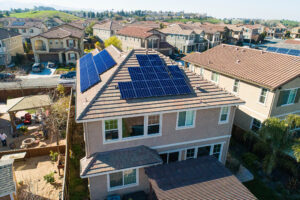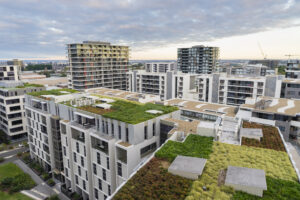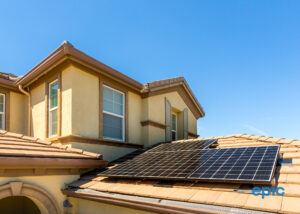Home energy efficiency is key to saving money and saving the planet. But with so many options to improve the efficiency of your home, it can be overwhelming. You might not want to deal with the hassle just because it feels like you can never know enough! But the upgrades that will make the biggest difference to your energy consumption are all in your roof.
Installing a cool roof, a solar roof or solar panels, and a green roof each makes a huge difference. But unfortunately, you can’t have all three. We’ll explore the pros and cons of each here.
Before we get into comparing them directly up against each other, we must first have a basic understanding of what each roofing type actually is and how it is energy efficient.
Cool Roof
The cool roof is as hip as it sounds. The “cool roof” as defined by the US Department of Energy, is “one that has been designed to reflect more sunlight and absorb less heat than a standard roof.”
Darker, non-cool roofs will absorb a lot of heat. This will heat up the interior of your home, costing you more in energy bills.
The cool roof prevents that by applying a reflective coating to the shingles. This can be done to your existing roof, or during the installation of new shingles. (That’s right! You don’t always have to replace your roof to convert it to a cool roof!)
Cool roofs are becoming more and more common as homeowners strive to be more energy efficient.
Solar Panels or Solar Roof
Solar panels are the second type of energy-efficient “roof“. While solar panels aren’t the materials your roof is made of, they do significantly affect the energy efficiency of your home.
Solar panels take energy from the sun and convert it into energy. This energy can go to your home, into the grid, or can be stored in batteries should a blackout (or Netflix marathon at 3 in the morning) ensue.
Depending on the size of your system, you could potentially offset the cost of your monthly electric bill entirely. This makes solar panels an economic and environmentally-friendly option.
A side note: there are actual solar roofs where the shingles themselves are made of solar panels. For example, Tesla has an elegant solar roof available. However, solar roofs are not yet a feasible expense for the average homeowner.
Green Roof
Green roofs are designed and constructed to house a variety of plant life. The vegetation acts as a barrier, preventing room-temperature air from escaping and atmospheric-temperature air from entering.
Green roofs also create mini biomes for plant and animal life to flourish. They give off oxygen while simultaneously cleaning the air, and they are extremely durable and resistant.
Not to mention, a green roof is absolutely breathtaking to look at.
Comparison Between Cool Roofs, Solar Panels, and Green Roofs
Each of these–the cool, solar, and green roofs–have their own pros and cons. The table below will help you knowingly and painlessly make a decision based on your specific needs, wants, and budget.
| Average Lifespan | Aesthetic | Ease of Installation | Average Cost | Average Payback Period | |
| Cool Roof | 20 to 100 years (depending on material) | Just about every type of roofing material can be made “cool” so the options are near endless | Simple; could be a DIY project | $1.50 – $3.00 per square foot | 6 years |
| Solar Panels | 20 to 25 years | Can be added to nearly every type of roof and have a sleek, modern design | Medium; requires professional, but it is not an intensive process | $2.58 – $3.38 per Watt | 8 years |
| Green Roof | 30 to 50 years | Beautiful, natural aesthetic that can be covered in trees, grasses, flowers, etc | Intense; extremely intensive and may require the whole roof to be redone | $10 per square foot | 6-7 years |
Conclusion
The quickest and easiest option to increase the energy efficiency of your home is a cool roof. It generally has the lowest cost, quickest payback period, and easiest installation.
However, solar panels will help offset the cost of energy bills even more in the long run. Additionally, the government helps supplement the cost of installation.
And green roofs have amazing insulation properties and are extremely durable against even the harshest weather conditions.
The answer is not so simple and you’ll need to take into account what matters most for you when it comes to your roof, your home, and your wallet.
No matter what you decide from these three, you’ll be getting a big bang for your buck. Plus, you’ll help not only yourself, but the planet as a whole.
References
https://www.certainteed.com/residential-roofing-commercial-roofing/what-cool-roof-0/
https://www.energy.gov/energysaver/design/energy-efficient-home-design/cool-roofs
https://coolroofs.org/resources/home-building-owners
https://www.tesla.com/solarroof
https://www.altestore.com/store/solar-panels-c541/
https://science.howstuffworks.com/environmental/green-science/green-rooftop.htm
https://www.go-gba.org/resources/green-building-methods/cool-roofs/
https://www.epa.gov/heat-islands/using-cool-roofs-reduce-heat-islands
https://www.gsa.gov/cdnstatic/Cost_Benefit_Analysis.pdf
https://news.energysage.com/how-much-does-the-average-solar-panel-installation-cost-in-the-u-s/
https://news.energysage.com/understanding-your-solar-panel-payback-period/
http://www.greenrooftechnology.com/green-roofs-explained
http://www.houstoncoolmetalroofs.com/cool-roof-information/cool-roof-save-money-investment/




